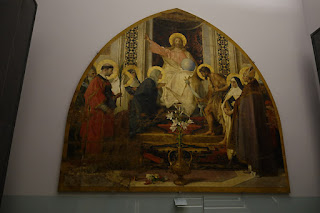Dear Art Lover,
Rudolph is one of my favorite Christmas
programs on TV. When I was at
university, I even bought the videotape and sang along loudly [alone, since my
flatmates thought that I was nuts]. The
arrangement and soothing voice of Burl
Ives singing “Silver and Gold”
always made me cry, as I inevitably thought of loves lost and the sweetness of loves
retained over the years. Here it is if
you wanna listen:
Artwise, I am still in the Museo dell’Opera
del Duomo in Florence, Italy. To be
honest, most of the time, I can out-museum most of my friends. However, in this period in which I have not
been very productive in my own art creating, I find my mind wandering no matter
how interesting the museum contents and presentation. This next work of art at first got the “Boh!”
response from me, as I peeked around the corner to gaze upon it. However, the Italian tour guide caught my
attention. He was very expressive and enthusiastic
about this piece, so I meandered over and started to photograph him as his
whole body told stories.
So much of this art is TOO silver and gold . . . it just seems
“over the top” and one sees the shine or glare, if you will, more than the
forms. However, upon closer look, it is
amazing the sheer skill and ideas put into this altar that was created in the
years from 1367 to 1483. It features
twelve scenes from the life of John the Baptist.
Again, I must quote the museum display:
“This room contains an altar front and a
monumental cross of pure silver, restored between 2006 and 2012, with a combined
weight of 250 kilograms in metal parts alone.
Commissioned by the Arte di Calimala – the cloth merchants’ guild – and
realised beginning in 1367 by artists spanning several generations, these
intricate assemblages of thousand of components were at the center of the
principal religious celebration of the Florentine Republic, the feast of the
city’s patron saint, John the Baptist, on June 24, when altar and cross were
installed in the church dedicated to Saint John, the Baptistery.”
On a side note, I am touched that my new community
is already involving me in the life here.
I have been asked to dress the part of a medieval sculptor [they provide
the clothes] for the town’s “Living Nativity” on Christmas Eve. It will feel great to have a hammer in my
hand again, even if I am unlikely to be using it on this occasion. Also, yesterday, I was asked to speak to the
local mayor’s assistant [in Italian he is called the Assessore, which looks like two funny English words put together
for a public servant’s title]. My local
friends seem to think that my new-to-the-community voice, especially as a
sculptor, will help them give some life to a seemingly forgotten decade-old
project.
Kelly
~ Kelly Borsheim, sculptor,
painter, writer, teacher

 |
| To the right is a video on the far wall that tells more of the story. |

















